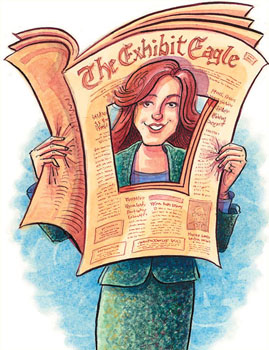|
|
|
Exhibitor Magazine "12 Steps to
Press Success" Features Interview on Karen Thomas, Thomas Public
Relations
By Lena Valenty,
Exhibitor Magazine
 
12 Steps to Press Success
Add prowess to your public-relations strategy
with these 12 simple steps from three PR pros,
and you'll woo even the most jaded industry
journalists.
Exhibiting at a trade show is a lot like going
on a blind date. Your booth has mere minutes to
make a lasting first impression on whoever
decides to give it a chance. To be more
appealing to your target audience, you’ve
carefully accessorized your space with graphics,
key messages, and a particular aesthetic that
represents — and accentuates — your company’s
best features. You want to appear interesting,
but not overeager. Confident, but not pompous.
Potential suitors include attractive prospects
such as buyers and distributors, but don’t
overlook the person that, at first glance, may
not seem like your type — the journalist.
Sure, his or her badge color isn’t quite what
you’re looking for, but don’t let that
negligible turnoff cloud your judgment.
Journalists, though perhaps not as glamorous as
buyers or distributors, have the potential to
catapult your company from Plain Jane mundane to
Press Princess. And all you have to do is primp
and preen your exhibit program a bit to
confidently court those members of the media. To
help you get started, we’ve compiled 12 steps
that require little more than your time and some
thoughtful planning.
Find your audience
The first step in informing the media about your
company’s presence at an upcoming trade show is
not as simple as crafting a generic “come visit
us at booth 555” e-mail and hitting “send.”
Before you blast out a press release announcing
show-related news to every journalist in your
Rolodex, you have to do some legwork. According
to Karen Thomas, president of Thomas Public
Relations Inc. based in Melville, NY, requesting
a list of preregistered press attendees from
show management is a good place to start.
“Research the people on the press list and visit
the publications’ and media outlets’ websites to
determine your key press targets,” she says.
Look for titles such as “editor in chief,”
“editor,” or “writer.” Then search for those
people’s bylines (using a search engine such as
Google) to find past articles and published
works and figure out if their beat aligns with
your company’s products or services.
“Use social media to not only build
relationships with your current clients and
prospects, but also with journalists,” Thomas
says. “By having a social-media presence, you
are increasing your company’s exposure, thereby
increasing the chance that members of the press
will catch wind of your company’s plans for the
show.” Though social media is an easy way to
reach out to the masses, Thomas stresses the
importance of communicating with your targeted
list of journalists via personal e-mail
correspondence as well.
Book interviews
Distributing press releases, maintaining e-mail
contact with targeted journalists, and having a
social-media presence are all part of a strategy
to get members of the media to your exhibit.
It’s unlikely that press will request interviews
out of the blue — unless there is already a lot
of buzz about your product or company. So be
proactive, and start booking press appointments
several weeks in advance of the show.
But even if you offer coffee or lunch, be
prepared for no-shows and rescheduling. “Missed
meetings happen — and a lot of times, writers
and editors will stop by the booth outside of
their scheduled time,” Thomas says. “So, it’s
important to be flexible from the get-go, and
ask for cell-phone numbers so you can touch base
with journalists during the show in case they
don’t show up, or need to reschedule on the
fly.”
Prepare your exhibit
If you decide to offer a gift, Thomas suggests
picking something useful — and lightweight. “In
my experience, journalists appreciate pens and
notepads, but absolutely love USB drives loaded
with all the company and product information
they need,” she says. “They also like free
product samples, and although some vendors
request the product back, I say let the
journalists keep it. You never know when they’ll
have an opportunity to write about your
product.”
If you don’t have a quiet area in your exhibit,
off-site meetings (such as at a restaurant over
breakfast or lunch) are often a welcome
alternative. Plus, they can be scheduled around
the exhibit-hall hours, reducing the risk of
time conflicts and missed appointments. Another
option is to host meetings in the show’s
pressroom, which most shows will allow.
Whether you conduct the interview in your
exhibit, the pressroom, or off site, be succinct
in communicating your content, make it
applicable to that publication’s readers, and
don’t keep anyone waiting.
http://www.exhibitoronline.com/exhibitormagazine/apr11/media-relations-12-steps-to-press-success.asp
-
The contents of all photos, graphics, and text are protected by copyright
and may not be used or reproduced without prior express written authorization from the
publisher.
|


